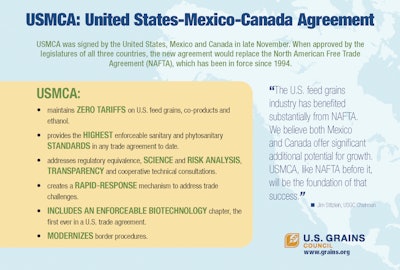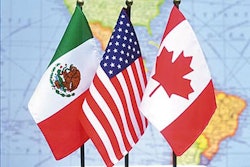
The United States-Mexico-Canada Agreement (USMCA), which went into effect on July 1, marks an important, positive milestone in trade negotiations between the three countries. Over the last three years, this effort required a massive collaboration between organizations like the U.S. Grains Council (USGC), farmers, agribusinesses and government officials.
The agreement includes several advantages for the agricultural sector, including:
- Maintaining zero tariffs on U.S. coarse grains, co-products and ethanol
- Providing the highest enforceable sanitary and phytosanitary standards in any trade agreement to date
- Addressing regulatory equivalence, science and risk analysis, transparency and cooperative technical consultations
- Creating a rapid-response mechanism to address trade challenges
- Modernizing border procedures
- Adding an enforceable biotechnology chapter — the first-ever in a U.S. trade agreement.
The work in the agricultural sector over the last three years to reach a fully approved trade agreement is emblematic of the geographically and logistically linked supply chains for U.S. grains in all forms (GIAF) between the United States, Mexico and Canada.
Trade interrelationships made possible by NAFTA
The most important provisions in the new USMCA preserve the foundational duty-free market access for U.S. coarse grains and co-products established by the North American Free Trade Agreement (NAFTA), which went into effect in January 1994. While zero tariffs opened the doors to trade, robust market development work by groups like USGC and its members helped develop highly efficient supply chains between all three countries that maximized natural geographic proximity.
Trade has flourished based on these positive logistical factors and increased ties between customers and suppliers on both sides of each border. Overall, exports of U.S. grains in all forms (coarse grains, co-products, ethanol and meat) have increased 309% to Mexico and 508% to Canada since the start of the agreement.
Mexico now dominates nearly every category of U.S. grains in all forms – setting a record high in the 2018/2019 marketing year at 25.6 million metric tons, equivalent to one billion bushels. By category, Mexico was the top buyer of U.S. corn, distiller’s dried grains with solubles (DDGS), barley/barley products in addition to ranking as the third-largest market of U.S. sorghum and the 10th largest market for U.S. ethanol.
Canada also set a record for imports of U.S. grain in all forms in 2018/2019, increasing purchases by nearly 10% to 8.03 million tons (316 million bushels). Those sales represented the second-largest market for U.S. ethanol and barley/barley products, the fifth-largest market for U.S. corn and the seventh-largest market for U.S. DDGS.
Strong relationships
This strong export growth to Mexico and Canada made completing the USMCA critical to maintaining and expanding these top markets. USGC worked extensively during the USMCA negotiation process with key officials in the U.S. Department of Agriculture (USDA) and the office of the U.S. Trade Representative (USTR).
USGC and its partners also worked with Mexico’s USDA-equivalent, Agriculture and Agri-Food Canada and industry representatives from the Mexican and Canadian livestock, agri-food trade and food and consumer products sectors. In addition, USGC maintained close contact with Mexican and Canadian customers to share concerns, ask questions and maintain open lines of communication.
In 2017, immediately following the announcement NAFTA would be renegotiated, USGC took to the road to talk to customers. In March, USGC leadership traveled to Mexico, followed by the USGC board of directors in June.
While in Mexico, these leaders were able to talk with both Mexican end-users and representatives of the Mexican government, including meetings with ANFACA, AMEPA and CONAFAB, major associations representing the local livestock feeding industries.
In August 2017, USGC organized a team of U.S. and Mexican media members to travel to south Texas and Mexico to see firsthand the value NAFTA has created and talk to key stakeholders in the negotiations — grain producers, exporters, buyers and users. The journalists visited U.S. farmers near the border, saw a border crossing as grain passed through by truck, and connected with one of the feed millers who accepted that grain just hours later.
In November 2018, leadership from both USGC and the National Corn Growers Association (NCGA) reiterated support for trade during an officers’ mission to Mexico. The next year, USGC and NCGA leadership on a subsequent mission by leaders from the United Sorghum Checkoff Program (USCP) and the National Barley Growers Association (NBGA) in again pledging support for the trade relationship during a mission to Mexico and building relationships with the presidential administration of Andrés Manuel López Obrador, as they prepared to take office in December.
All of these activities allowed USGC to continue its engagement with longtime partners in Mexico and Canada, provide timely input to U.S. negotiators and keep members informed about the progress of the talks and the status of the U.S. market share throughout.
USGC works to capture future market demand
Throughout the negotiation period, day-to-day market development activities continued, as they have for USGC’s 30-year history in Mexico.
Trade teams traveled to the United States to examine the value chains for all the commodities USGC represents — corn, DDGS, ethanol, barley, sorghum. Regional events like the Ethanol Summit of the Americas, Export Exchange and Export Sorghum all provided additional opportunities for customers in Mexico and Canada to meet directly with U.S. farmers, agribusiness suppliers and government officials.
On the ground in Mexico and Canada, USGC’s staff have conducted feeding trials, explored expanded supply chain options, discussed crop quality, held educational seminars and continued to show why the United States is the most reliable and transparent supplier of coarse grains, co-products and ethanol to these markets.
The USCMA provides the framework needed to turn these ongoing market development activities into realized sales in addition to solidifying two of the consistent top markets for U.S. feed grains in all forms. Mexico and Canada offer significant additional potential for growth. USMCA, like NAFTA before it, will be the foundation of successfully capturing that demand for U.S. farmers and agribusinesses. ■
Cary Sifferath serves as the senior director of global programs for the U.S. Grains Council. Sifferath is responsible for oversight of the USGC’s 10 international offices and all worldwide programs.















